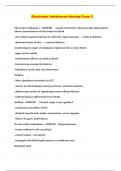Electrolyte Imbalances Nursing Exam 2
Electrolyte Imbalance - ANSWER -serum electrolyte value provides information
about concentration of electrolyte in blood
-electrolytes gained and lost in relatively equal amounts --> body in balance
-abnormal route of loss ---> uneven balance
monitoring for signs of imbalance important for at-risk clients
-signs can be subtle
-multisystem effects can lead to death
-interactions among electrolytes
-imbalance rarely only one electrolyte
Sodium
-Most abundant electrolyte in ECF
-Assists in maintaining osmotic pressure, acid-base balance
-aldosterone assists in regulating serum sodium balance
-sodium balance affected by food intake
Sodium - ANSWER -Normal range is 136-145mEq/L
-maintains osmolality of ECF
-skeletal muscle and cardiac contraction+ nerve impulse
-Where Na goes, H2O follows
Na electrolyte imbalance - ANSWER Hypernatremia
-serum sodium levels>145 mEq/L
-critical values > 160 mEq/L
-managed with fluid replacement at a moderate rate
Hyponatremia
,-Serum sodium levels <125 mEq/L
-Critical values <115 mEq/L
-Managed with sodium-containing fluid/food
Hyponatremia - ANSWER -Na <135
-results in decreased nerve transmission and in cellular swelling
-actual sodium deficits
-relative sodium deficits
-can be fatal
Ex- psychiatric disorders, SIADH, HF, cirrhosis of liver
Hyponatremia Side effects - ANSWER Cerebral- confusion, disoriented,
headache, dizziness, seizures, coma
Neuromuscular- difficulty breathing
Intestinal- diarrhea, abdominal cramping
Cardiovascular- varies, but pulse can be weak and thready. BP low
Integumentary- dry skin
Hyponatremia nursing interventions - ANSWER -assess for neuro changes,
seizure precautions
-monitor foods high in Na, processed meat, pickled chips
-Safety
-monitor I&Os, labs, daily weight
-replacement therapy
-IV, serious cases, hypertonic 3% solution, but could quickly lead to heart failure
-Teaching- heat/humidity: daily weights, report early signs and symptoms
(abdominal cramping, muscle weakness, nausea)
Hypernatremia signs and symptoms - ANSWER CNS: agitation, confusion , short
attention span and maniac behavior or lethargic, drowsy
,Skeletal muscle: twitching and irregular contractions, then bilateral weakness and
diminished reflexes
Cardiovascular: tachycardia with either bounding and increase BP or thready
decreased BP
GI: Diarrhea, nausea, thirst
Integumentary: dry, sticky mucous membranes with rough dry tongue and flushed
skin
Hypernatremia: nursing interventions - ANSWER -safety seizures
-watch response to therapy to prevent hyponatremia
-monitor
-dietary modifications- low salt diet
-teaching
-I&O, weight, VS, labs, LOC
Potassium - ANSWER 3.5-5.0 mEq/L
-heart (potassium + magnesium)
-Irritant to neuro junction
-Na/K pump
-Kidneys
-Intracellular cation
-role in cellular depolarization, repolarization
-component of potassium pump
Potassium electrolyte imbalance - ANSWER Hyperkalemia
-serum potassium levels >5.3 mEq/L
, -critical values 7.0 mEq/L
-managed with administration of calcium, gluconate, insulin and glucose,
kayexalate
Hypkalemia
-serum potassium levels < 3.5 mEq/L
-critical values <2.5 mEq/L
-Managed with replacement of potassium salts
Hypokalemia - ANSWER Resp- shallow resp
musculoskeletal changes- weakness
cardiovascular- thread/weak pulse and orthostatic hypotension
neurologic changes- mental status change
intestinal changes- decreased peristalsis (N/V, constipation, Abd distension)
Hypokalemia Interventions - ANSWER -The priorities for nursing care of the
patient with hypokalemia are ensuring adequate oxygenation and patient safety
for falls prevention, preventing injury from potassium administration and
monitoring the patients response to therapy
-Teaching: Supplements with H2O
-Give IV slowly and dilute it b/c effects on the heart no greater than 20 MAQs per
hour
Hyperkalemia - ANSWER -Cardiovascular- irregular slow HR, hypotension and
ECG changes




